Discovering stars: what types of telescopes are there
11th Aug 2022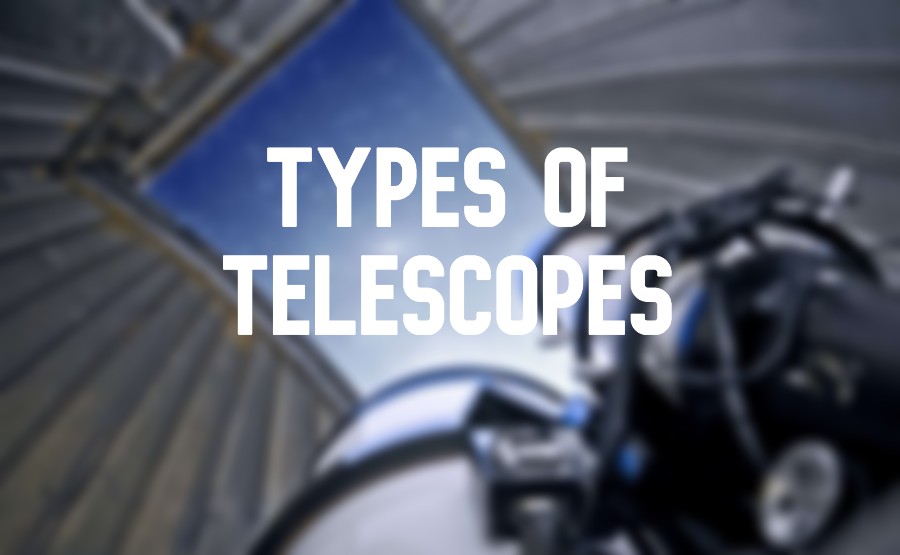
Many modern astronomical discoveries would have never been made without a telescope. We have already discussed the telescope inventor and first telescope models in our article on the history of space exploration. In this article, we will tell you about all existing types of telescopes and how they work.
8 main types of telescopes
For over 300 years, the telescope capabilities have remained very limited. In fact, it was an improved version of a spyglass, with higher magnification and a smaller viewing angle, which made it possible to see not only terrestrial objects but also some cosmic ones up close. Only the technological development of the 20th century allowed scientists to develop different types of telescopes capable of obtaining data on celestial bodies at various frequencies of the electromagnetic spectrum. So let’s learn what types of telescopes do astronomers use.
Optical telescopes
The most ancient devices are still in use. What types of telescopes are considered to be optical telescopes? These are telescopes that collect light at the wavelength of the electromagnetic spectrum visible to the naked eye. The main feature of such a device is its luminosity, which is much higher than that of the human eye. There are three types of optical telescopes.
Refractors (dioptric)
Refractors use a special convex lens or lens system on both sides to focus incident light. Such a telescope was invented in the early 17th century by Galileo Galilei.
Lenses refract light rays and bring them into focus, building up an image. An eyepiece is used to view it. The larger the lens, the longer the optical tube must be to focus the image.
In today’s research, refractors are barely used. The largest refractor in the world belongs to the Yerkes Observatory (USA); it has a lens diameter of 102 cm and a focal length of 19.4 m. Larger devices don’t make sense. Long-focus refractors have a very large secondary spectrum and their photo images are blurry. It seems that refractors have reached their upper limit, and the future of astronomy will depend on other devices.
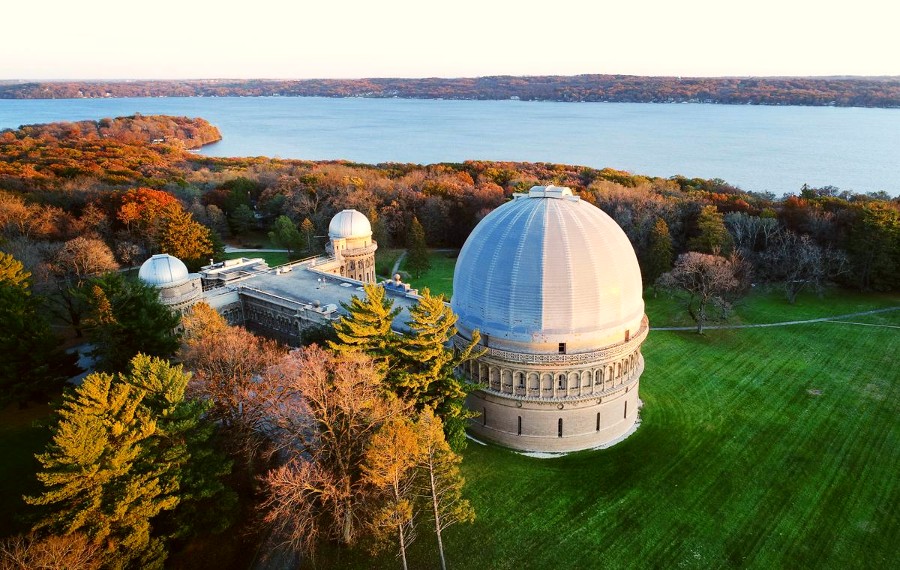
What can you see with a 70mm refractor telescope?
Even though refractors are of little use for major research, they remain one of the most popular portable types of telescopes for private use. For example, a refractor with a lens diameter of 70 mm has a 140x magnification with a tube length of only 1 m, so it is ideal for home use. In it, you can see half of the planets of the solar system.
The Moon, the closest celestial body to Earth, is visible best of all — a viewer can clearly distinguish most of its seas and craters. On Mars, the poles and the largest regions are clearly visible. Jupiter will most likely appear as a light yellow spot and Neptune as a sky blue dot. The rings of Saturn may be recognizable under certain conditions, but Pluto and other dwarf planets in the solar system will be beyond the reach of a compact refractor.
Reflector (catoptric)
The reflector uses mirrors as light-gathering elements. This type of telescope was first built by Isaac Newton in 1668 based on the drawings of Johannes Kepler. The main advantage of a reflector over a refractor is the absence of significant chromatic aberration (image distortion). The disadvantage is the need for constant collimation, adjusting the telescope’s optical axis to obtain a high-quality image.
Reflectors are the most common among research telescopes because, at a relatively low cost, they allow one to view small or very distant objects with high clarity.
5 types of reflector telescopes
There are 5 different types of reflector telescopes, named after the scientists who invented the types of optical designs they use:
- Newton,
- Gregory,
- Cassegrain,
- Ritchey – Chretien,
- Herschel-Lomonosov.
The largest operating reflecting telescopes in the world are The Gran Telescopio CANARIAS (GTC) and the Large South African Telescope (SALT). The first is located on top of the extinct volcano Muchachos on the island of La Palma in Spain at an altitude of 2396 m above sea level. The diameter of its mirror, consisting of 36 hexagonal segments, is 10.4 m, and the area is 74 sq. m. SALT is located in South Africa in a semidesert area near the village of Sutherland at an altitude of 1798 meters above sea level. The main mirror of this telescope consists of 91 segments.
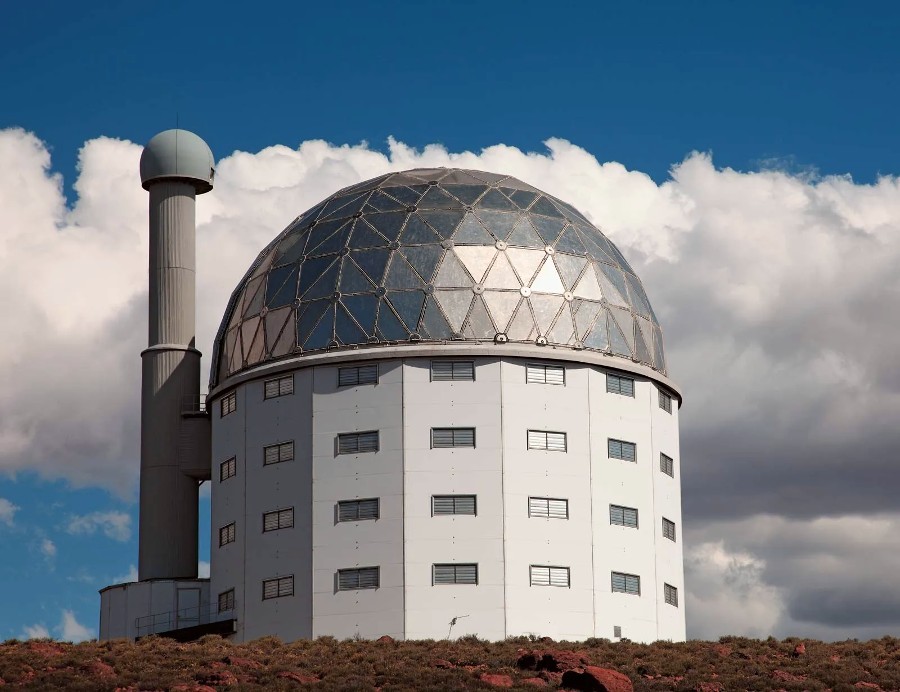
Catadioptric
Catadioptric telescopes combine elements of reflecting and refracting instruments, that is, they use both mirrors and lenses. Such a scheme is widely used in car headlights, searchlights, telephoto lenses, fast lenses, but for telescopes, it has a number of significant drawbacks. In particular, due to the complexity of manufacturing a large-sized corrector, catadioptric devices rarely exceed 2 m in diameter, which makes them practically unsuitable for astrophysical purposes. However, they are in demand in astrometry (the study of the geometric and kinematic properties of celestial bodies). The most common types of mirror-lens telescopes are the Schmidt-Cassegrain and Maksutov-Cassegrain telescopes.
Radio telescopes
Radio telescopes detect radio wave signals from distant astronomical objects. The most important component of such a device is a parabolic antenna (dish), the size of which determines the measurement accuracy. In some cases, several radio telescopes operate in concert(radio interferometry), which greatly increases their search area.
China’s FAST (Five-hundred-meter Aperture Spherical Telescope) is the world’s largest radio telescope. It is located in southern China in Guizhou province.
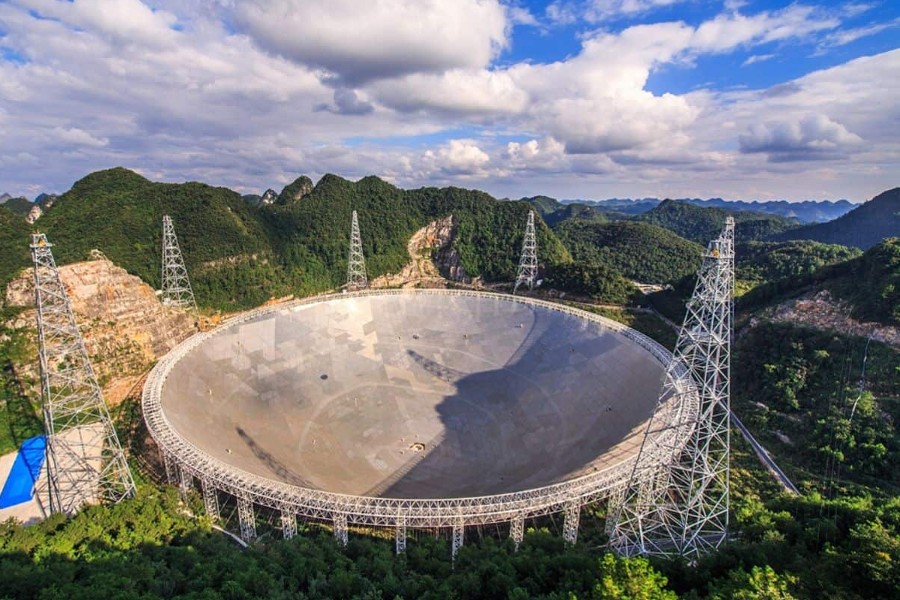
Solar telescopes
Solar telescopes, formerly known as photoheliographs, are designed for ground-based sun observations. These are usually designed for near-infrared and ultraviolet wavelengths. Unlike most other telescope types, these devices can only operate during daylight hours.
The largest solar telescope is at the McMath Pierce Observatory, located on Mount Kitt Peak in Arizona (USA). It consists of the main and two additional telescopes. The main telescope is a tower-mounted 1.6-meter mirror that directs sunlight down a long light shaft. This shaft is inclined 32° to the horizon, and mostly runs underground. Such a system makes it possible to obtain an image of the Sun with a diameter of 75 cm. To prevent the mirror from overheating from direct sunlight, the building is protected by a copper coating. The temperature of the coating is maintained at a constant level using a cooling liquid flowing through a pipe system.
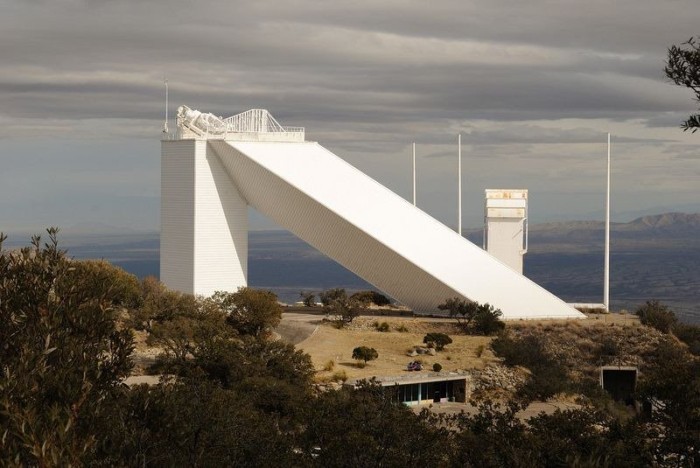
Types of telescopes in space
Unlike ground-based telescopes, space telescopes offer more accurate measurements because they are free from atmospheric turbulence and radiation distortion. Some are are based on reflectors. Others use detectors that measure light at wavelengths that do not or weakly penetrate the Earth’s atmosphere.
Infrared telescope
The main advantage of this telescope type is its ability to detect distant astronomical objects in dusty regions of space. However, infrared observation is difficult because any warm object emits infrared radiation. To cope with this, infrared telescopes operate at cryogenic temperatures (below -150 °C).
The first infrared telescope in orbit was IRAS, a joint project of the USA, the UK, and the Netherlands. It was launched in 1983. Spitzer, launched by NASA in 2003, was one of the leading infrared space telescopes. It ceased operation in 2020. A year later, the much more powerful James Webb replaced it.
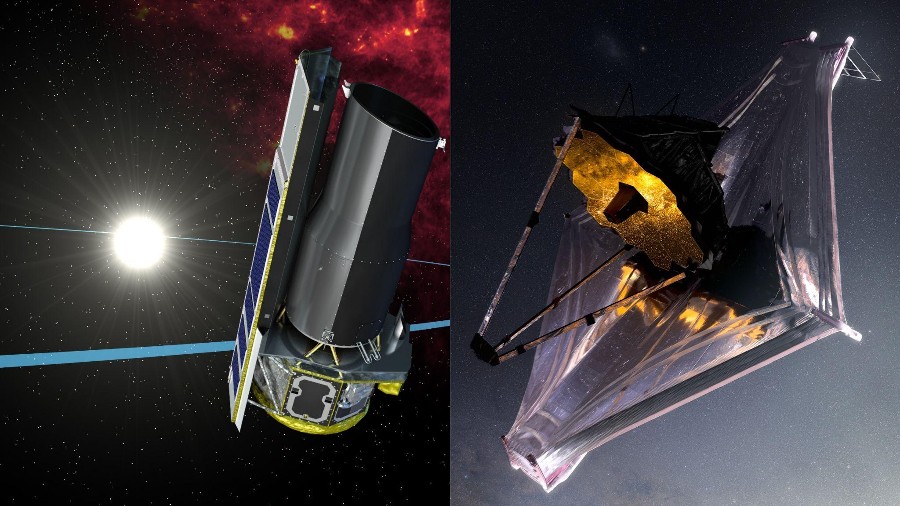
Ultraviolet telescopes
Ultraviolet telescopes are similar to infrared and optical devices but allow a closer look at distant stars and galaxies. Stars that are either at an early or late stage of evolution and much hotter than the rest are usually visible in this spectrum.
The Apollo 16 mission in 1972 deployed the first space telescope operating in the UV spectrum. This was camera/spectrograph on the lunar surface. From 1999 to 2007, the main UV telescope at LEO was FUSE (Far Ultraviolet Spectroscopic Explorer), launched under the NASA Origins program. The main purpose of FUSE was to study the abundance of deuterium, an isotope of hydrogen left after the Big Bang.
Х-Ray Telescopes
Better known as Wolter telescopes because they use special X-ray optics — grazing incidence mirrors, most often made of gold or iridium.
X-ray telescopes are relatively common, with over 50 placed into orbit since the 1960s. Launched in 1999, NASA’s Chandra X-ray Observatory was a breakthrough in X-ray astronomy. Chandra is 100 times more sensitive to weak X-rays than any other telescope in existence.
By far, eROSITA (extended ROentgen Survey with an Imaging Telescope Array) is the most the most famous, or notorious X-ray telescope recently. eROSITA is located on board the German-Russian observatory Spektr RG. The consortium launched it in 2019 and expected to make seven detailed starmaps within four years. In particular, the team built eROSITA to study the location of black holes in the galaxies closest to the Milky Way. However, in February 2022, Germany turned off eROSITA in protest against the Russian military invasion of Ukraine. In response to this, Russia decided to hijack the German telescope. On June 11, the now former head of Roscosmos, Dmitry Rogozin, ordered the operation of eROSITA without the consent of Germany. Rogozin claimed that Roscosmos specialists would check whether they can operate the German telescope, and the whole process may take from two to four months.
The Russian Academy of Sciences did not support the actions of their colleagues from Roscosmos. Scientists said that if they try to turn on eROSITA on their own, Roscosmos will encounter technical problems that will not allow them to control the telescope.
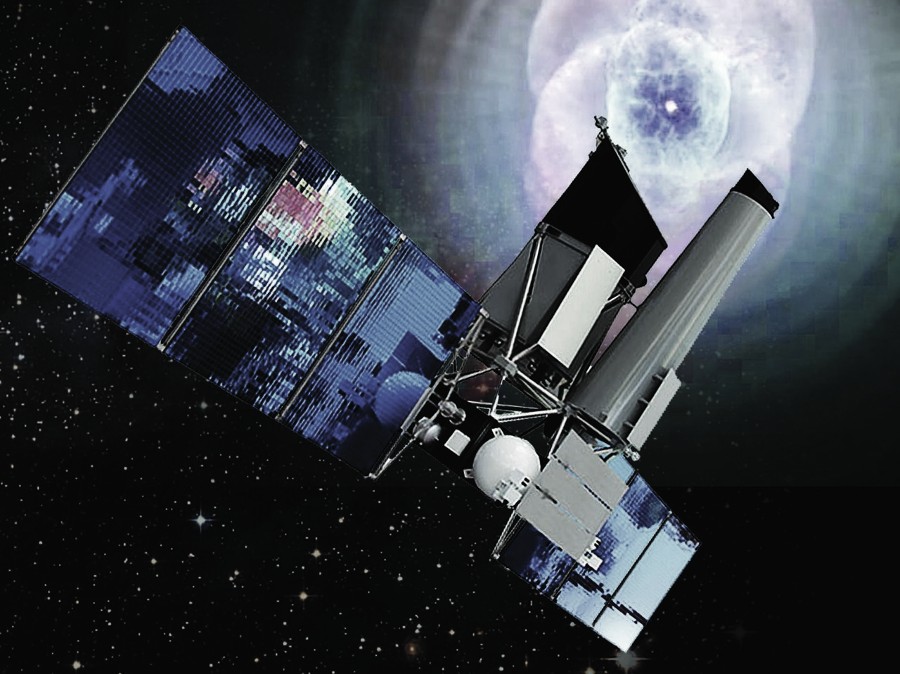
Microwave telescopes
This type of space telescope makes it possible to study the universe’s evolution since the Big Bang by measuring the cosmic background, synchrotron, and bremsstrahlung (braking radiation) from our galaxy.
WMAP NASA (Wilkinson Microwave Anisotropy Probe) and ESA Planck are the most famous microwave telescopes. The first one operated from 2001 to 2010, and the second one — from 2006 to 2013. At the moment, there are no active microwave telescopes in space.
Gamma telescopes
With their help, astrophysicists study pulsars, supernovae, black holes, galactic nuclei, and dark matter. Although Earth’s atmosphere is usually a barrier to gamma rays, they can sometimes be observed from the ground. Earth-based observatories with gamma-ray detectors include HESS, HAWC and VERITAS.
Combined telescope types
While most types of telescopes only observe or listen to a certain wavelength, several multi-wavelength telescopes can simultaneously collect information from several regions of the electromagnetic spectrum.
Swift Gamma Ray Burst Explorer
NASA’s orbital observatory launched in 2004 and still operating. There are three types of telescopes on board SWIFT:
- BAT (Burst Alert Telescope).
- XRT (X-ray Telescope)
- UVOT (UltraViolet/Optical Telescope)
Originally designed to study gamma-ray bursts, Swift functions as a general-purpose multiwavelength observatory, especially for rapidly tracking and characterizing astrophysical transients of all types. Over 17 years, it has made over 25 major discoveries and now observes an average of about 70 objects a day.
Hubble
This joint NASA and ESA orbiting telescope project has been studying the universe for over 32 years. The Hubble mirror, with a diameter of 2.5 m and its detectors allow observation in the near-infrared, visible and ultraviolet ranges. The absence of the atmospheric influence makes the Hubble telescope’s resolution 7-10 times greater than that of a similar ground-based telescope. During its operation, Hubble took over a million pictures and made several dozen important discoveries.
The veteran telescope is expected to end operations in 2026. In 2030 the observatory will deorbit and impact the Pacific Ocean.

However, space will not remain unattended. The James Webb Telescope is already on duty and is managing honourably. To date, this is the most powerful of all telescope types that have ever operated in space. This means that new, even more, sensational discoveries of the countless mysteries in our boundless Universe wait ahead.






Thank you for your comment! It will be visible on the site after moderation.